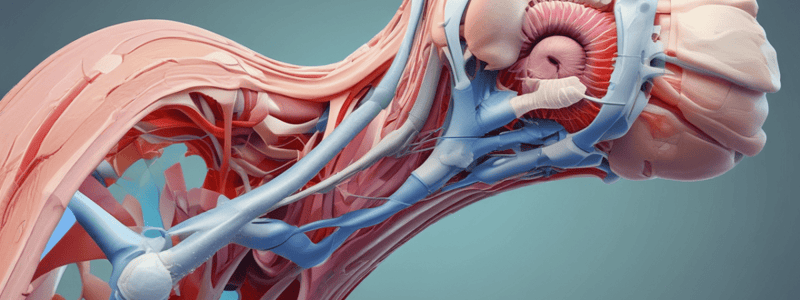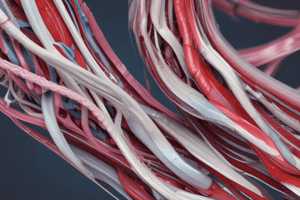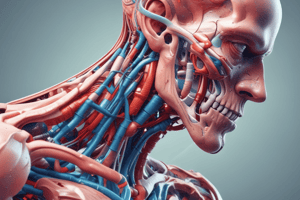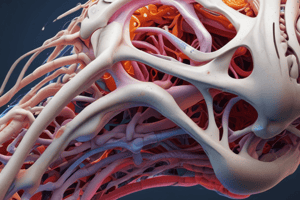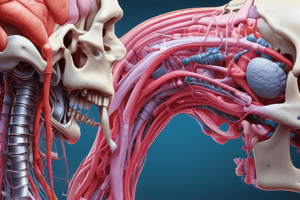Podcast
Questions and Answers
What is the primary function of tendons?
What is the primary function of tendons?
- To allow for joint flexibility and range of motion
- To provide structural support for the body
- To connect bone to muscle and transmit force from muscle to bone (correct)
- To store and release energy during movement
Which of the following is NOT a component of the structure of tendons?
Which of the following is NOT a component of the structure of tendons?
- Elastin fibers
- Proteoglycans
- Bone cells (correct)
- Collagen fibers
Which of the following mechanical properties of tendons is MOST important for their function?
Which of the following mechanical properties of tendons is MOST important for their function?
- Bending stiffness
- Compressive strength
- Shear strength
- Tensile strength (correct)
What is the primary effect of stress deprivation on the mechanical properties of tendons?
What is the primary effect of stress deprivation on the mechanical properties of tendons?
Which of the following is a key biological factor that affects the mechanical behavior of tendons?
Which of the following is a key biological factor that affects the mechanical behavior of tendons?
During the healing process of a tendon injury, which mechanical property INITIALLY decreases the most?
During the healing process of a tendon injury, which mechanical property INITIALLY decreases the most?
What is the function of the paratenon surrounding tendons?
What is the function of the paratenon surrounding tendons?
What fills the space between the parietal and visceral membrane in synovial sheaths?
What fills the space between the parietal and visceral membrane in synovial sheaths?
What type of collagen is present in the paratenon?
What type of collagen is present in the paratenon?
Where is the epitenon located in relation to the paratenon?
Where is the epitenon located in relation to the paratenon?
What angle do the Epitenon fibers form with the tendon axis initially?
What angle do the Epitenon fibers form with the tendon axis initially?
Which structure adds a mechanical advantage to flexion under the annular pulleys?
Which structure adds a mechanical advantage to flexion under the annular pulleys?
What is the primary function of the musculotendinous unit?
What is the primary function of the musculotendinous unit?
What is the key compositional difference between tendons and ligaments?
What is the key compositional difference between tendons and ligaments?
What is the primary function of the tendon synovial sheath?
What is the primary function of the tendon synovial sheath?
How do the general biomechanical behaviors of tendons and ligaments differ?
How do the general biomechanical behaviors of tendons and ligaments differ?
What is the function of the myotendinous junction (MTJ) and the osteotendinous junction (OTJ) within the musculotendinous unit?
What is the function of the myotendinous junction (MTJ) and the osteotendinous junction (OTJ) within the musculotendinous unit?
What is the primary role of the tenocytes and tenoblasts within the musculotendinous unit?
What is the primary role of the tenocytes and tenoblasts within the musculotendinous unit?
What is the primary role of the tenocytes within tendons?
What is the primary role of the tenocytes within tendons?
Which of the following is NOT a factor that affects the mechanical behavior of tendons?
Which of the following is NOT a factor that affects the mechanical behavior of tendons?
During the healing process of a tendon injury, which mechanical property is LEAST affected initially?
During the healing process of a tendon injury, which mechanical property is LEAST affected initially?
What is the primary function of the synovial sheath surrounding tendons?
What is the primary function of the synovial sheath surrounding tendons?
Which of the following is a key biological factor that affects the mechanical behavior of tendons during aging?
Which of the following is a key biological factor that affects the mechanical behavior of tendons during aging?
What is the primary function of the musculotendinous unit?
What is the primary function of the musculotendinous unit?
Which of the following statements about the musculotendinous unit is NOT true?
Which of the following statements about the musculotendinous unit is NOT true?
What is the primary function of the tendon synovial sheath?
What is the primary function of the tendon synovial sheath?
Which of the following statements best describes the biomechanical behavior of tendons?
Which of the following statements best describes the biomechanical behavior of tendons?
Which of the following statements about the composition of tendons and ligaments is true?
Which of the following statements about the composition of tendons and ligaments is true?
What is the function of the myotendinous junction (MTJ) and the osteotendinous junction (OTJ) within the musculotendinous unit?
What is the function of the myotendinous junction (MTJ) and the osteotendinous junction (OTJ) within the musculotendinous unit?
What is the primary function of the paratenon surrounding tendons?
What is the primary function of the paratenon surrounding tendons?
What is the primary function of the synovial (peritendinous) fluid found in the space between the parietal and visceral membranes of synovial sheaths?
What is the primary function of the synovial (peritendinous) fluid found in the space between the parietal and visceral membranes of synovial sheaths?
Which of the following statements accurately describes the function of the paratenon surrounding some tendons?
Which of the following statements accurately describes the function of the paratenon surrounding some tendons?
What is the primary function of the epitenon surrounding the tendon fibrillar network?
What is the primary function of the epitenon surrounding the tendon fibrillar network?
How do the Epitenon fibers reorient themselves when the tendon is stretched?
How do the Epitenon fibers reorient themselves when the tendon is stretched?
Under the annular pulleys, which structure adds a mechanical advantage to flexion?
Under the annular pulleys, which structure adds a mechanical advantage to flexion?
What is the primary function of the synovial cells present in the parietal sheet of synovial sheaths?
What is the primary function of the synovial cells present in the parietal sheet of synovial sheaths?
Flashcards are hidden until you start studying
Study Notes
Tissue Mechanics IV: Ligament/Tendon Structure and Metabolism
- Tendons transmit tensile forces created in the muscle to the bone
- Composed of collagen and elastin embedded in a matrix of proteoglycan and water
- Synthesized by tenocytes and tenoblasts
- Proximal attachment: each muscle has proximal and distal tendon
- Distal attachment: myotendinous junction (tendon-muscle) and osteotendinous junction (tendon-bone)
Tendon vs. Ligament: Composition
- Tendons: muscle to bone, transmit tensile forces
- Ligaments: bone to bone, limits joint motion
- Compositional differences between tendons and ligaments
Tendon Micro-architecture
- Tendons withstand unidirectional tensile loads
- Ligaments resist high tensile loads in one direction and smaller tensile loads in other directions
Tendon and Surrounding Structures
- Tendon synovial sheaths: closed duct around tendons gliding on bone surfaces
- Synovial sheaths composed of two membranes: inner (visceral) and outer (parietal) sheets
- Space between parietal and visceral membrane filled with synovial (peritendinous) fluid
- Facilitates smooth gliding of tendons and aids in nutrition
- Under annular pulleys, adding a mechanical advantage to flexion
Paratenon and Epitenon
- Paratenon (peritendinous sheet): reduces friction in tendons without synovial sheath
- Composed of loose fibrillar tissue (type I and III collagen)
- Functions as an elastic sleeve permitting free movement of tendon against surrounding tissue
- Inner surface has synovial cells
- Epitenon: located under paratenon, surrounds tendon fibrillar network of collagen
- Strands run oblique, longitudinal, or transverse to the long axis of the tendon
- Epitenon fibers at 60° to the tendon axis, reorient to 30° after stretching (angle decreases)
Objectives
- Describe the components and organization of dense regular connective tissues (tendons and ligaments)
- Describe the mechanical behavior of tendons and ligaments in response to tensile loads
- Describe physical and biological factors affecting the mechanical behavior of tendons and ligaments
- Discuss the response of tendons and ligaments to stress deprivation and remobilization
- Describe the mechanical properties of tendons and ligaments during healing
Studying That Suits You
Use AI to generate personalized quizzes and flashcards to suit your learning preferences.
